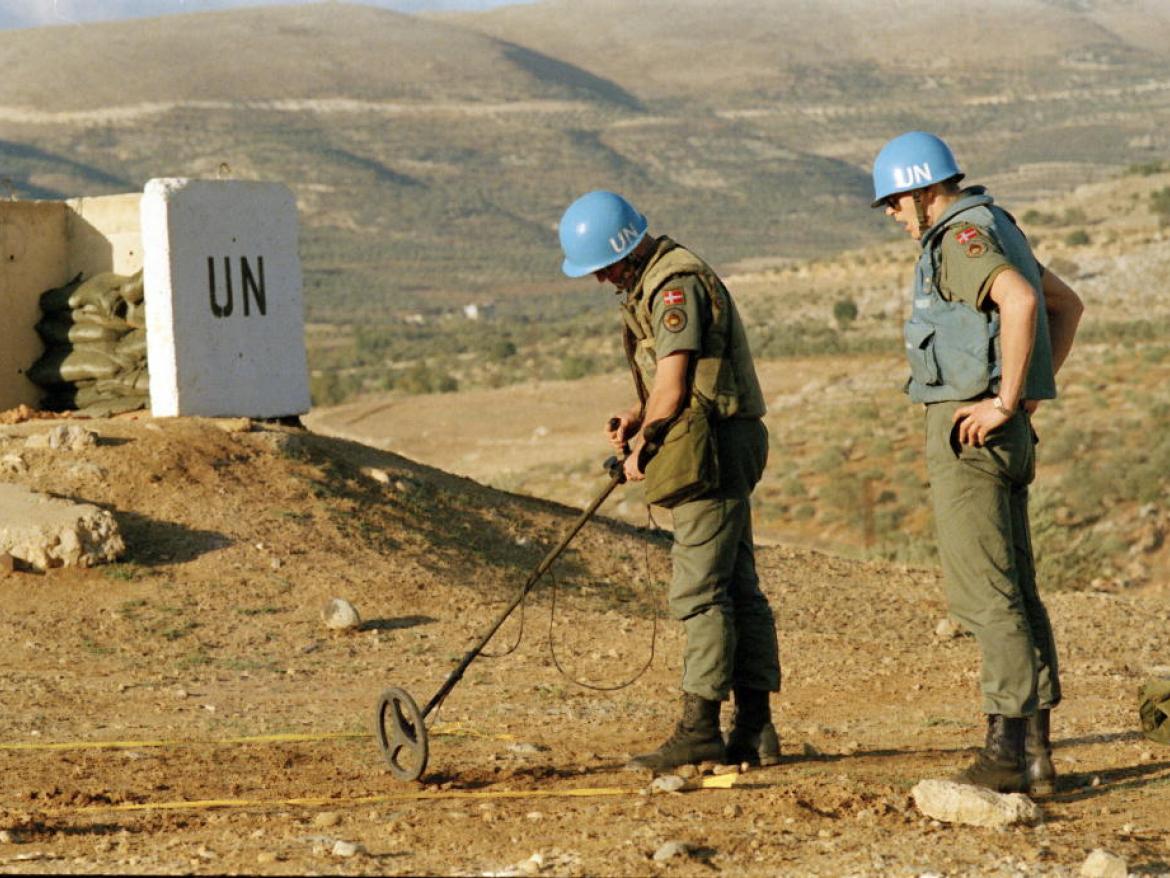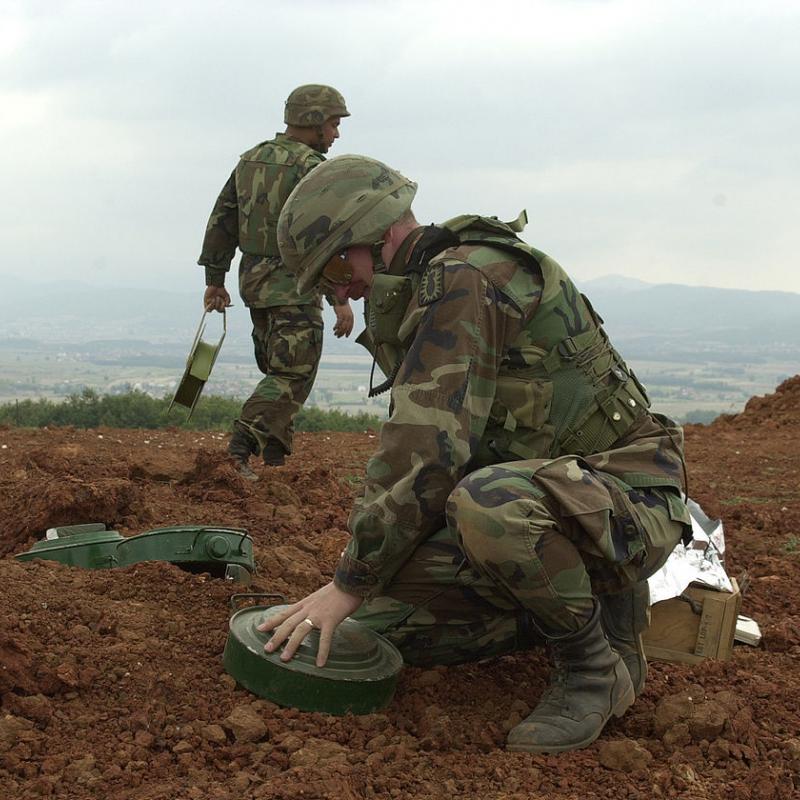On June 21, 2022 President Biden announced a near-global ban on anti-personnel landmine use by the United States, fulfilling his campaign promise to reverse the Trump administration’s anti-personnel landmine policy.
Since 2020, the Trump administration had allowed the Department of Defense to use, develop, produce, or otherwise acquire landmines anywhere in the world. Here’s what you need to know about anti-personnel landmines and U.S. policy.
What are landmines? | What’s in the new policy? | What is the impact of landmines? | What are “smart” landmines? | Where are they deployed? | Who else uses them? | What is the Mine Ban Treaty?
What are landmines?
Landmines, also known as anti-personnel mines, are defined as mines “designed to be exploded by the presence, proximity or contact of a person and that will incapacitate, injure or kill one or more persons.”
They cannot distinguish between civilian or combatant. Landmines do not follow ceasefires or peace processes – they lie dormant for decades and continue to inflict suffering on civilians long after a conflict ends.
What’s in the new landmine policy?
In June 2022, President Biden announced a new near-global ban on anti-personnel landmine (APL) use by the U.S. military and set the goal of “ultimately acceding to the Ottawa Convention.” Under the 2022 APL policy, the United States will begin to comply with key parts of the 1997 Mine Ban Treaty, which requires that countries renounce the use, development, production, acquisition, transfer, and stockpiling of these indiscriminate weapons.
However, the 2022 policy allows for the continued stockpiling and use APLs for the defense the Korean peninsula—essentially reinstating the Obama administration’s 2014 policy on APLs.
What is the impact of landmines?
Landmines are indiscriminate weapons that disproportionately impact civilians, and especially children. From 1999 through 2020, there have been 143,382 reported casualties as a result of landmines, though the true number is likely much higher as accurate data is difficult to gather. Last year was the sixth year in a row of high casualties as a result of landmines, with more than double the number of casualties in 2020 than in 2013.
According to the Landmine Monitor, in 2020 alone:
- Landmines caused at least 7,073 casualties in 2020, over a third of which were deaths.
- Civilians accounted for 80% of landmine casualties.
- Children accounted for at least 50% of all civilian casualties, an increase from 2017.
What are “smart” landmines?
Claims by the U.S. military that some landmines are “smart” or “non-persistent” are false. Efforts to create “smart mines” through self-destruct and self-deactivation mechanisms have failed to function as advertised. The Government Accountability Office found that “smart mines” deployed in the Gulf War failed at a rate 150x higher than the Department of Defense had reported. Additionally, while so-called “non-persistent” landmines contain mechanisms that shorten the lifespan of the trigger, the explosive materials remain—and with it their lethality, indiscriminate nature, and ability to harm civilians.
These mines are rarely hand-planted, carefully mapped, and marked. Instead, they are often scattered by aircraft and artillery over unmarked terrain, creating further danger for civilians and aid workers who have no way of knowing whether they are in or entering a minefield.
The self-destruct timers Russia deployed landmines have created terror among civilians during its ongoing invasion of Ukraine. According to one survivor, whose farm was hit with scatterable landmines, “the bursts continued throughout the day with intervals around 50 minutes, and the last one was around 3 o’clock the next night after it first landed […] It was lucky that kids didn’t play there that day, normally they would play in the backyard at the time of the first pieces detonating, but it was rainy that day.”
Where are they deployed?
As of October 2021, landmines have contaminated over 60 countries, with hundreds of thousands of people living under threat. These include countries like Cambodia, Laos and Vietnam, which collectively have hundreds of thousands of acres of land contaminated by American-dropped unexploded ordnance.
Two world wars and the ongoing Russian invasion, have left Ukraine contaminated with roughly 300,000 square kilometers of landmines and other unexploded ordinances—over half its territory. The contamination of eastern Ukraine has been estimated to impact the lives of roughly two million people by hindering access to schools, farms, and hospitals and harming, and even killing, civilians and children. Removing these landmines is dangerous and tedious, and experts believe it could take a decade to demine the country.
The United States currently has no active minefield under its control. The minefields the U.S. once implanted on the Korean Peninsula are now the responsibility of South Korean forces. The last large scale confirmed use by the United States was in 1991 in Iraq and Kuwait, when U.S. forces deployed 117,634 antipersonnel mines. However, it is reported that U.S. forces in Afghanistan deployed Claymore directional fragmentation mines in 2009 and 2010.
Who uses them?
Of the more than 50 countries that once produced landmines, 40 have ceased production, including four that are not party to the Mine Ban Treaty. Following President Biden’s reversal of the Trump-era landmine policy, the United States is no longer a part of the small handful of one-time mine-producing countries that have not disavowed restarting production, including China, Russia, Cuba, India, Iran, Myanmar, North Korea, South Korea, Pakistan, Singapore and Vietnam.
Between October 2015 and 2021, only the government forces of Syria, Myanmar, and North Korea, and most recently Russia, as well as non-state actors in conflict areas, have used landmines.
What is the Mine Ban Treaty?
The Convention on the Prohibition of the Use, Stockpiling, Production and Transfer of Anti-Personnel Mines and on Their Destruction, also referred to as the Ottawa Convention or the Mine Ban Treaty, was adopted in 1997.
The 164 countries that are party to the Mine Ban Treaty as of February 2020, representing over 80% of the world’s states, are required to:
- Not develop, produce, acquire, use, retain, stockpile, or transfer anti-personnel landmines, or assist or encourage others in such actions.
- Destroy all current stockpiles of anti-personnel landmines.
- Identify and clear all mined areas under their jurisdiction or control within 10 years.
- Assist other states in clearing and destroying mines if able, and provide assistance to landmine victims.
- Report annually to the U.N. any landmines under their control, and the status of efforts to destroy them.
The Mine Ban Treaty, aided by the International Campaign to Ban Landmines and Cluster Munitions, has made a massive contribution towards global peace and security through the destruction of over 53 million antipersonnel mines.
However, so long as 32 nations—including the United States, Russia, China, India and Pakistan—are not party to the Mine Ban Treaty, the world continues to live under threat.
What more needs to be done?
President Biden’s 2022 landmine policy set the goal of “ultimately acceding to the Ottawa Convention.” However, the inclusion of the “Korean exception” prevents full alignment with the Treaty.
This “Korean exception” is outdated and unnecessary. The need to use APLs in defense of the Korean Peninsula has been used as an excuse by successive administrations not to join the treaty for more than two decades. In reality, the APLs already emplaced on the peninsula cause ongoing harm to civilians and create obstacles to peace.
FCNL urges the White House to quickly end the Korean Exception, destroy U.S. stockpiles, and put the United States fully in line with the global consensus against these weapons. President Biden should work with the Senate to quickly accede to the Mine Ban Treaty. FCNL calls on Congress to pass legislation that bans the use, development, and production of landmines, and to prohibit their funding.


